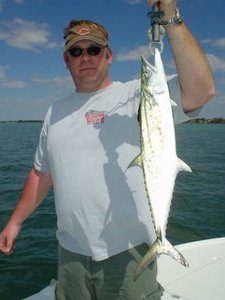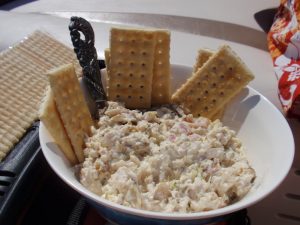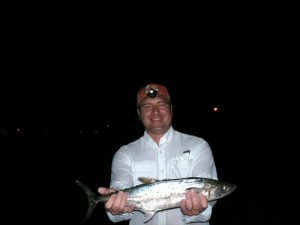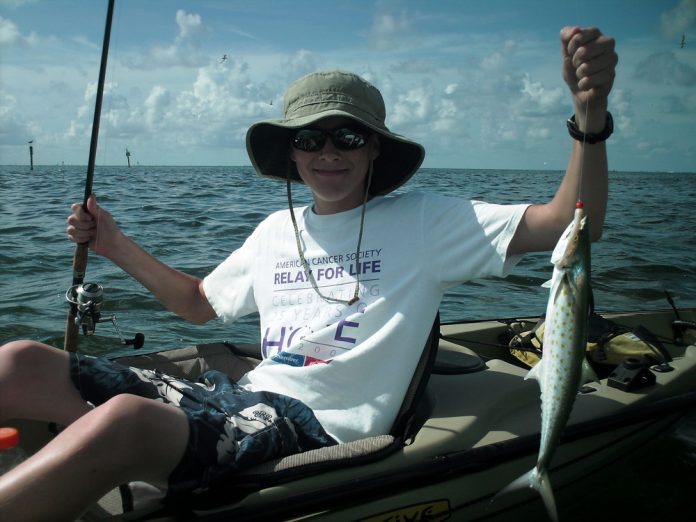Scomberomorini The Spanish Mackerel
By Neil Taylor and capmel.com resources (MyFWC.com and FoodReference.com)
There are a lot of different opportunities in the Tampa Bay area. We have fish that stay year-round, we have some that pass by for shorter periods of time. The Spanish Mackerel falls somewhere in between. The Spanish mackerel is notorious for a springtime arrival and can usually be caught here until the first major cold fronts of Fall. A certain number will be caught throughout the summer months. Many will continue up the coastline toward the Florida Panhandle.
One of the first thing that comes to mind with this species: They have teeth. They have a mouth full of razor blades. Your regular flats leaders simply won’t “cut it” and furthermore the will “cut it.” It is a better idea to go up in leader size, a minimum of 30# but a better choice is 40#. This leader is adequate. King mackerel require some wire. Do not go this route for the Spanish. This strength leader will hold up. Pay attention during your fishing and cut and retie your lures if you see the leader line showing signs of shavings from mackerel teeth.

I am inspired by mackerel. Mackerel are one of those fish that are a personal thrill. There is an abundance and usually a quality size around the Tampa Bay area. They hit hard and they are flat out “speedsters.” Their food value is a funny one. Personally, I don’t care for them how I like to eat other fish. I am a smoker guy. Mackerel that go on ice in my cooler, they are going to be in low heat and heavy smoke. The fish spread that results (see article below) is the #1 choice of my friends.
One option for getting in on a lot of mackerel action, fish the structure. Instead of going through it all here, look at this article I wrote on Pier fishing. It is an easy “drive up” option that you can really utilize for success. The Skyway Fishing Piers are about the best choice but there are other options as well.
“Pier Pressure”, Catching fish from our local piers and bridges:

http://www.capmel.com/qpier-pressureq-catching-from-florida-piers/
Use the current! If you are in areas that do not have tidal flow you are likely where there aren’t many mackerel. So, where should you go? Pretty simple there are two big philosophies I think you should embrace: #1, fish the passes and hard bottom areas. #2 is related to #1, “fish where the bait is.” The bait is usually where the hard bottom is. The Skyway structures is one example. You will find mackerel on every reef inshore and offshore. Areas of significant current? Gulf Passes, the opening of Tampa Bay: Any narrow areas that provide better water movement. It doesn’t necessarily have to be a main Gulf Pass. There are other locations where there is similar water movement, baitfish and MACKEREL. A #3 to consider is also “decent water depth”, it happens but it is unusual to catch them in less than four feet of water. Keep a look out. Hovering birds and explosions on the water will tell you exactly where there are mackerel.

Now you have a better idea where to find them, now, now to catch them:
You have the right gear, leader and lures (you have your choice, I would use the ones I have listed below). You are in the right spot. You have feeding mackerel in front of you. Presentation of lures is an interesting question. I would say, in general, “Keep them swimming. Mackerel want to hit a moving target. How fast? It depends on the lure, in particular the weight of the lure. Mackerel junkies out there, so many of them will show you a lure called a Gotcha Plug. It is a great lure but it is heavy. You are going to be able to cast it a long way and you are going to want to move it FAST. The way I do it, much the same as other fishing I do, I go as light as possible so with less weight I have to move mine slower to get strikes.
I use a variety of offerings. I use my pompano jigs/teasers. I use other kinds of “jigs” including a standard jighead with a paddle tail and some other “Crazy Jigs”. All of them are flashy. Pretty much all of them include an Uncle Neil custom teaser.
Throwing heavier lures the fish often hook up on the initial strike. The way I do it with lighter lures, there will be more misses. How to hook up more with the light lures, the biggest tip I can give you is to loosen the drag and let the fish hook themselves. Rod tip down, if they fish can take some line on the strike, you will hook more. If they miss, usually another fish is all over the lure.
Mackerel are without a doubt one of our most fun to catch. They are going to make your hands slimy (and the butt of your rod and reel seat will have a million tiny slimy, smelly scales with good action). They can figure into some meals. I mentioned the smoker and fish spread. The only other way I will process my mackerel is by cooking them in milk. Boiling milk will cook the oil out of the meat and also fluff up the fillets a little.
Keep your fingers away from their mouths and you will be just fine. Read on for some other info on the species and good luck to you in your mackerel pursuits!
Neil Taylor
From Myfwc. Com
“Habitat and Fishing tips:
Spanish mackerel are a pelagic, fast swimming fish that are prevalent throughout Florida’s coastal waters when water temperatures exceed 70 degrees. To remain in warm water, Spanish mackerel migrate out of the northern parts of the state in the fall of the year and return in April with the warming waters. They are frequently found in shallow, clear water over grass beds and along sandy beaches where they feed on schools of baitfish. Spanish mackerel are aggressive feeders that will strike a wide variety of natural and artificial baits, so they can be very easy to catch. Many anglers identify the location of Spanish mackerel by trolling or watching for birds diving on schools of baitfish, which often indicates that mackerel are forcing the bait to the surface. Angling techniques include trolling or casting with small shiny spoons, dusters or jigs. Light spinning or bait-casting tackle with 10 to 15 pound monofilament line is adequate; however, 30 to 60 pound monofilament leader is required due to the mackerel’s razor sharp teeth.
State Record:
12 lb, caught near Ft. Pierce”
Gear Requirements:
- Legal Gear: beach or haul seine, cast net, hook and line, spear
Florida Regulations:
| Regulations | Gulf State Waters | Atlantic State Waters |
| Minimum Size Limit | 12” fork length | |
| Daily Bag Limit | 15 per harvester per day | |
http://www.foodreference.com/html/art-spanish-mackerel-7806.html
Now is the time to enjoy delicious, healthy Spanish Mackerel. Spanish Mackerels have darker meat and are one of the tastiest of the Mackerel family. Spanish Mackerels are also one of the richest sources for Omega-3 fatty acids. These are the polyunsaturated fatty acids with huge health benefits. They are easily filleted and excellent eating baked, broiled, steamed, smoked, poached, or fried.
DESCRIPTION
Spanish Mackerels are beautifully colored finfish caught off both Florida coasts. Their slender bullet-shaped bodies are blue and silver, spotted with golden yellow or olive ovals. They are distinguished from the Cero or King Mackerel in having these spots without stripes on the sides, and in lacking scales on the pectoral fins.
Spanish Mackerels are members of the large family of fish that include the Tunas and other Mackerels. Although these fish vary greatly in size, they share many common characteristics including being very fast, powerful swimmers. The average size of Spanish Mackerel is from 2-3 pounds, while a weight of 9-10 pounds is considered large.
Spanish Mackerels are considered coastal pelagic fin fish, forming immense, fast-moving schools that range the open seas of the Atlantic Ocean, from New York to the Gulf of Mexico. In the late summer and early fall this species migrates southward to spend the winter and early spring along Florida’s southern coast. Spanish Mackerels do not appear to move freely around the Florida Keys, creating separate Gulf and Atlantic populations.
SPANISH MACKEREL ATTRIBUTES
Moderate texture, dark meat with full flavor. Lean fish.
SUBSTITUTE SPECIES
Mullet, Swordfish, King Mackerel.
HOW MUCH TO BUY
- Whole or drawn fish: 3/4 to 1 pound per serving.
• Dressed or cleaned fish: 1/2 pound per serving.
• Fillets or steaks: 1/4 to 1/3 pound per serving.
BUYING, STORAGE AND HANDLING
Remember to purchase seafood last and keep it cold during the trip home.
Fresh whole fish should have:
— A shiny surface with tightly adhering scales.
— Gills that are deep red or pink, free of slime, mucus & off-odor.
— Clean shiny belly cavity with no cuts or protruding bones.
— A mild aroma, similar to the ocean.

Fresh steaks, fillets and loins should have:
— A translucent look.
— Flesh that is firm and not separating.
— A mild odor, similar to the ocean.
— No discoloration.
— Packaging that keeps them from being bent in an unnatural position.
- The Neil Blog… - July 26, 2023
- The Catfish - July 26, 2023
- update - July 22, 2023











